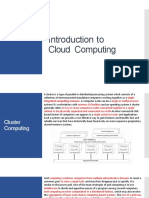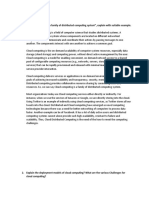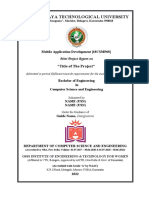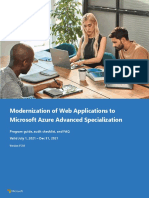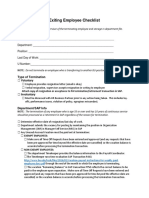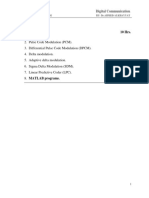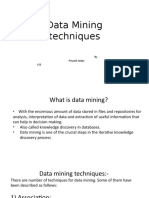Cloud Computing vs.
Distributed
Computing: A Comparative Analysis
Abstract: Cloud computing and distributed computing are two paradigms that enable
efficient data processing and resource management across multiple systems. This
paper aims to provide a detailed comparison between cloud computing and distributed
computing, exploring their architectures, deployment models, advantages, challenges,
and use cases. Understanding these differences is crucial for organizations to choose
the appropriate model based on their specific requirements.
1. INTRODUCTION
In today’s digital landscape, organizations require robust computing capabilities to
handle vast amounts of data and execute complex applications. Cloud computing and
distributed computing have emerged as two popular solutions, each offering unique
benefits and challenges. While they share some similarities, they differ significantly in
their architecture, deployment, and use cases. This paper explores these differences in
detail.
2. DEFINITIONS AND CONCEPTS
2.1 Cloud Computing:-
Cloud computing is a model that provides on-demand access to a shared pool of
configurable computing resources (e.g., servers, storage, applications) over the
1
�internet. It allows users to access and utilize resources without requiring direct
management of the infrastructure.
2.2 Distributed Computing:-
Distributed computing refers to a model where computing tasks are distributed across
multiple interconnected computers that work collaboratively to achieve a common
goal. Each node in a distributed system operates independently but communicates with
other nodes to share data and resources.
3. ARCHITECTURAL DIFFERENCES
3.1 Cloud Computing Architecture:-
Cloud computing typically follows a service-oriented architecture (SOA) and consists
of two main components:
Front-End: This includes user devices and applications that interact with cloud
services through the internet.
Back-End: The cloud provider’s infrastructure comprises servers, storage
systems, and data centers managed by the provider, which users access via the
internet.
3.2 Distributed Computing Architecture:-
Distributed computing architecture consists of multiple independent nodes
(computers) connected via a network. Each node can act as both a client and a server.
Key components include:
Nodes: Individual computers or servers that perform computations.
Network: The communication framework that allows nodes to share data and
resources.
Middleware: Software that facilitates communication and management among
nodes, ensuring efficient resource allocation and task execution.
2
� 4. DEPLOYMENT MODELS
4.1 Cloud Computing Models:-
Cloud computing can be deployed in several models:
Public Cloud: Services are offered over the internet to multiple clients (e.g.,
AWS, Microsoft Azure).
Private Cloud: Dedicated infrastructure for a single organization, enhancing
security and control.
Hybrid Cloud: A combination of public and private clouds, allowing flexibility
and scalability.
4.2 Distributed Computing Models:-
Distributed computing can be classified into different models based on architecture:
Cluster Computing: A group of linked computers that work together to
perform tasks as a single system.
Grid Computing: A network of dispersed computers that collaborate to
complete large tasks.
Peer-to-Peer (P2P): Each node functions as both a client and server, sharing
resources directly with one another.
5. ADVANTAGES AND CHALLENGES
5.1 Advantages of Cloud Computing:-
Scalability: Cloud resources can be easily scaled up or down based on demand.
Cost Efficiency: Pay-as-you-go pricing models reduce the need for large capital
investments.
Accessibility: Resources are accessible from anywhere with an internet
connection.
3
�5.2 Challenges of Cloud Computing:-
Security Concerns: Storing sensitive data off-site can raise security issues.
Vendor Lock-in: Organizations may become dependent on specific cloud
providers, complicating migration.
Downtime Risks: Outages can affect accessibility and productivity.
5.3 Advantages of Distributed Computing:-
Resource Utilization: Enables effective use of available resources across
multiple systems.
Fault Tolerance: Distributed systems can continue operating even if some
nodes fail.
Performance: Parallel processing across nodes can lead to faster task
execution.
5.4 Challenges of Distributed Computing:-
Complexity: Designing and managing distributed systems can be more
complex than centralized systems.
Latency: Communication delays between nodes can impact performance.
Security: Ensuring secure communication among distributed nodes poses
challenges.
6. USE CASES
6.1 Use Cases for Cloud Computing:-
Web Hosting: Businesses leverage cloud services to host websites and
applications, ensuring scalability during traffic spikes.
Data Storage and Backup: Organizations use cloud storage solutions for
secure data backup and recovery.
Software Development and Testing: Cloud environments enable developers to
build, test, and deploy applications quickly.
4
�6.2 Use Cases for Distributed Computing:-
Scientific Research: Projects requiring vast computational power (e.g.,
simulations, modelling) utilize distributed computing for resource sharing.
Big Data Processing: Distributed systems are employed for processing large
datasets across multiple nodes (e.g., Hadoop).
Blockchain Technology: Distributed computing forms the backbone of
blockchain systems, ensuring decentralized transactions and data integrity.
7. CONCLUSION
Cloud computing and distributed computing are two distinct paradigms that offer
unique benefits and challenges. Cloud computing excels in scalability and cost-
effectiveness, making it ideal for businesses seeking flexible IT solutions. In contrast,
distributed computing provides enhanced resource utilization and fault tolerance,
suitable for high-performance computing tasks. Understanding the differences
between these two models is essential for organizations to make informed decisions
based on their specific computing needs.
REFERENCES:-
1. Armbrust, M., et al. (2010). "A view of cloud computing." Communications of
the ACM, 53(4), 50-58.
2. Mell, P., & Grance, T. (2011). "The NIST Definition of Cloud Computing."
National Institute of Standards and Technology.
3. Foster, I., et al. (2001). "Cloud computing and grid computing 360-degree
compared." Grid Computing Environments Workshop, 2001, 1-10.
4. Buyya, R., & S. K. (2009). "Market-Oriented Cloud Computing: Vision, Hype,
and Reality for Delivering IT Services as Computing Utilities." Proceedings of
5
�the 10th International Symposium on Pervasive Systems, Algorithms, and
Networks.























